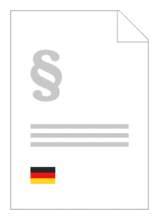
Standard [CURRENT]
VG 85528:2015-11
Cable diagrams for submarines - Markings for the connection of cable shields; Text in German and English
- German title
- Kabelpläne für Unterwasserfahrzeuge - Kennzeichen für den Anschluss von Kabelschirmen; Text Deutsch und Englisch
- Publication date
- 2015-11
- Original language
- German, English
- Pages
- 16
- Publication date
- 2015-11
- Original language
- German, English
- Pages
- 16
Product information on this site:
Quick delivery via download or delivery service
All transactions are encrypted
The use of shielded cables is widespread and not limited to submarines of the German Navy. The cable shield generally consists of a concentric wire mesh or of a metal foil that surrounds the individual wires of the cable. In this way, the currents flowing through the wires (the wanted signals) can be protected from electromagnetic interference. In order to achieve a defined "shielding effect", the braid shall be connected to a suitable potential, mostly reference ground, at one or both ends of the cable. With the help of identifiers in the circuit diagram, this standard specifies the way (with a metal clamp, soldering, conductive adhesive, etcetera) and at which location (metal housing, terminal, soldering terminal) this connection shall be made. It is also noteworthy that in English usage a distinction is made between the shielding effect ("screen/ing") and the body producing this effect ("shield"): "A shielded cable has a screening effect." This standard has been prepared by Working Committee NA 132-03-54 AA "Installationssysteme, Kabelverlegung auf Schiffen" ("Installation systems, cable installation on ships") of the DIN Standards Committee Shipbuilding and Marine Technology (NSMT).
Cooperation at DIN
